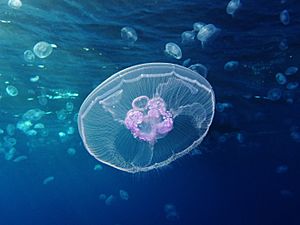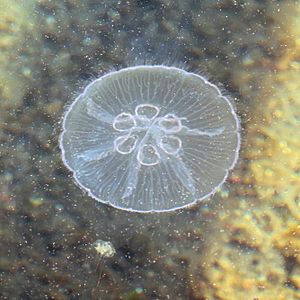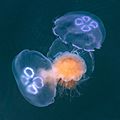Aurelia aurita facts for kids
Quick facts for kids Aurelia aurita |
|
|---|---|
 |
|
| Aurelia aurita, Red Sea | |
| Scientific classification | |
| Genus: |
Aurelia
|
| Species: |
aurita
|
The Aurelia aurita, also known as the moon jellyfish, is a common and well-known type of jellyfish. You might also hear it called the common jellyfish, moon jelly, or saucer jelly. It belongs to a group of jellyfish called Aurelia. All jellyfish in this group are very similar. It's hard to tell them apart without special tests. So, what you learn about the moon jellyfish usually applies to all Aurelia species.
This jellyfish is almost clear, like glass. It usually grows to be about 25 to 40 centimeters (10 to 16 inches) wide. You can easily spot its four horseshoe-shaped parts, called gonads, through its bell-shaped body. The moon jellyfish eats tiny sea creatures like plankton and small mollusks. It catches them with its tentacles and brings them inside to digest. It can only move a little bit on its own. Mostly, it just floats along with the ocean currents.
Contents
Where Moon Jellyfish Live
The Aurelia group of jellyfish lives in oceans all over the world. You can find them from warm tropical areas to colder waters far north and south. The Aurelia aurita species is found along the eastern coast of Northern Europe. It also lives on the western Atlantic coast of North America, in places like New England and Eastern Canada. Generally, Aurelia jellyfish prefer to live closer to shore. They are often seen in estuaries (where rivers meet the sea) and harbors.
Aurelia aurita can live in ocean water temperatures from 6 to 31 degrees Celsius (43 to 88 degrees Fahrenheit). They are happiest in temperatures between 9 and 19 degrees Celsius (48 to 66 degrees Fahrenheit). They like temperate seas with steady currents. These jellyfish have even been found in water that is not very salty.
Moon jellyfish can handle low oxygen levels in the water. This is common in summer when the water is warm and has less dissolved oxygen. While most sea creatures move away from low oxygen areas, moon jellyfish stay. They can even keep feeding normally when oxygen is low. This gives them an advantage over other predators like fish. Fish struggle to feed when oxygen is scarce. This means moon jellyfish have less competition for food like zooplankton. Low oxygen conditions in places like Tokyo Bay in Japan actually help moon jellyfish grow and survive.
What Moon Jellyfish Eat
Aurelia aurita and other Aurelia species eat tiny organisms called plankton. This includes many different small creatures. They eat mollusks, crustaceans, and different kinds of larvae. They also eat rotifers, young polychaetes, and protozoans. Even tiny diatoms, eggs, and fish eggs are on their menu. Sometimes, they even eat other small, jelly-like animals.
Moon jellyfish use their tentacles to catch food. These tentacles have special stinging cells called nematocysts. These cells help them catch prey and protect themselves. Once food is caught, it's covered in mucus. Tiny hairs, called cilia, then move the food into the jellyfish's body. Inside, special chemicals break down the food. Moon jellyfish can digest things like carbohydrates, proteins, and lipids (fats).
Moon Jellyfish Body System
Moon jellyfish do not have lungs or gills like fish. They breathe by taking in oxygen directly from the water. Oxygen passes through their thin body covering. Inside their body, they can push out water with low oxygen. Then, they bring in fresh water with more oxygen. This helps them get enough oxygen into their cells. Their flat, wide body shape also helps them absorb more oxygen and nutrients.
The moon jellyfish has a simple body plan. It does not have systems for breathing, getting rid of waste, or circulating blood. An adult moon jellyfish looks clear. It has a bell-shaped body with tentacles around the edge. It has four bright parts called gonads under its stomach. Food moves through a muscular tube. Canals spread the food throughout its body. It has a middle jelly-like layer and outer skin. A network of nerves helps it swim and feed. Adult moon jellyfish can grow up to 40 centimeters (16 inches) wide.
Moon jellyfish are either male or female. Their life starts as a tiny larva called a planula. This larva has small hairs and swims freely. After a day or two, it attaches to a surface. Then, it changes into a small polyp called a "scyphistoma." This polyp then divides into many tiny jellyfish, called ephyrae. These ephyrae swim away and grow into adult jellyfish. They grow from less than 1 millimeter as a planula to about 1 centimeter as an ephyra. Finally, they become several centimeters wide as an adult jellyfish.
A recent study found that A. aurita can sometimes reverse their life cycle. This means they can become younger instead of older. This is similar to the "immortal jellyfish," Turritopsis dohrnii. Another study showed that moon jellyfish are not harmed by tiny plastic beads. These beads are sometimes found in cosmetics. The jellyfish can tell that these microbeads are not food. So, they do not cause any harm to the jellyfish's body.
Who Eats Moon Jellyfish?
Moon jellyfish are a good source of healthy fats for predators. Many animals eat Aurelia aurita. These include the huge ocean sunfish and the leatherback sea turtle. Other jellyfish, like Phacellophora camtschatica and Aequorea victoria, also eat them. Recently, it was seen in the Red Sea that two fish that usually eat plants also eat moon jellyfish.
Sea birds also feed on moon jellies. Birds might be more interested in the small creatures that live on the jellyfish's bell. But they still cause damage to the jellyfish. Moon jellyfish are often found floating near the surface of bays.
Moon jellyfish usually live for several months. After they reproduce, they naturally die. It's rare for them to live more than about six months in the wild. However, in aquariums, they can live for several years. In the wild, warm summer water and constant reproduction weaken them. They also have less food to repair their bodies. This makes them more likely to get sick from bacteria or other diseases. These problems often cause most moon jellyfish to die. Some tiny parasites also attack Aurelia aurita and other jellyfish species.
Gallery
-
Aurelia aurita in the Pairi Daiza aquarium, Belgium.
-
Aurelia sp. from the Monterey Bay Aquarium
Images for kids
-
Three moon jellies captured by a lion's mane jellyfish
See also
 In Spanish: Medusa común para niños
In Spanish: Medusa común para niños









